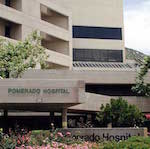By Joanne Barnett, MSN, RN; Kristin Beseke, BSN, RN, CEN; Kristin Davis, BSN, RN; Shelly Ortega, BSN, RN; Brita Thibault, BSN, RN; Amy Martinez, BSN, RN
Patients who leave the emergency department (ED) without care put both themselves and the hospital at risk. Here's how the ED team at Palomar Medical Center Poway (Calif.) used a unique, evidence-based intervention to decrease walkouts and boost patient satisfaction. The following is adapted from a poster presented at Vituity's annual conference.
Introduction
ED waiting rooms can be full of potentially critically ill patients. Often, these patients are neither monitored nor reassessed following triage. Nor is there an easy way for them to communicate their needs to staff.
Unless patients are updated regularly on their plan of care, they are at risk for anxiety, frustration and leaving without medical treatment. (In CMS lingo, they "leave without being seen," which is abbreviated LWBS.)
Leaving the ED without care can have serious consequences for both patients and hospitals, including:
- Decrease in patient satisfaction
- Decrease in patient safety
- Hospital liability
- Lost revenue for the hospital (ED facility fees, inpatient admissions, etc.)
Historically, the LWBS rate in our ED has been low. In 2014, the department saw 29,336 patients, and 328 (or just over 1 percent) left before seeing a provider.
While we met our national and organizational benchmarks that year, new challenges were emerging. Like many EDs, our patient volumes were rising following the expansion of healthcare coverage. Wait times were also increasing. Probably as a result, our LWBS rate crept up to 1.5 percent in early 2015.
We decided to act quickly before the problem spiraled. Fortunately, two of our ED nurses (Amy Martinez, RN, and Kristin Beseke, RN) applied for and received a research grant from the local Evidence-Based Practice Consortium to study the problem and trial
evidence-based interventions.
Methods
Through a review of the literature, Martinez and Beseke learned that ED wait times alone
don't predict patient satisfaction. Patients who received updates and information about delays were much more positive about their ED experience, regardless of the number of minutes waited. This was even truer when they perceived ED staff as courteous and empathic.
Based on these findings,
several hospitals experimented with waiting room rounding as a strategy to boost patient satisfaction and decrease LWBS rates — generally with good results.
Armed with this knowledge, Martinez and Beseke applied SBAR (a standardized communication technique endorsed by The Joint Commission) to the problem:
- S (Situation). When wait times are long and patients are uninformed, they are more likely to leave.
- B (Background). The annual LWBS target for our ED is 1 percent.
- A (Assessment). Research shows that patients are much more willing to wait for their care if they know the length or cause of the delay in advance. Rounding in the reception area plays a vital role.
- R (Recommendation). Our goal is to decrease the LWBS rate from 1.5 percent to 1 percent. This translates into 35 additional patients seen per year and an expected revenue increase of $34,571.
Based on this analysis, we implemented a seemingly simple intervention. Namely, when there are 5 or more patients in the waiting room, or any patient has been waiting longer than 30 minutes, the charge nurse rounds in the waiting room to inform patients about:
- Cause and expected length of delay
- Individual's plan of care
- What the department is doing to accommodate their needs
How rounding works:
- Charge nurse prints a patient "roster" from the tracking system.
- Charge nurse visits with each waiting room patient, using a script to guide the encounter.
- A rounding log is used to document each patient's length of stay and the information communicated.
If a patient is found to have left without treatment:
- The triage or charge nurse initiates an immediate callback to request the patient's return. If the patient agrees, the nurse works with providers to prioritize the encounter and secure space for the patient.
- The ED manager follows up with LWBS patients via a telephone call on the same or following day. This promotes patient safety and service recovery.
The plan was presented to all stakeholders and refined with their input. Our team agreed on the following implementation plan:
- Go-live: July 1
- Data collection from June through September to assess whether waiting room rounding decreases LWBS rate
- Analysis of results: October
- Result dissemination: November onward
Results
During the trial, LWBS rates decreased form 1.5 percent to 0.6 — far exceeding our goal.
In addition, our overall Press Ganey (patient satisfaction) scores increased by 8 percentage points. The greatest gains were seen on items addressing nurse communication (26 percentage points).
Conclusions
While our results were exciting, we have to be careful about attributing them solely to waiting room rounding. Our ED team had several improvement projects in the works during that period that probably contributed to the drop in LWBS rate.
It's also worth noting that we weren't always consistent in our rounding. The main reason is that it takes time to achieve buy-in and culture change. In particular, we're striving to instill the idea that every patient is in the ED for a good reason. We must express to them that they're valued and welcome, even if they don't necessarily have an emergent condition.
Despite these caveats, we do feel that waiting room rounding has had a positive effect on our operational performance. We plan to continue the process and report our results. We'll also be educating staff and providers about rounding and the rationale behind it.
One question we hope to answer through our data analysis is whether waiting room rounding can be delegated to other team members (triage nurses, technicians, etc.). The literature suggests this approach has worked for other EDs. Getting more team members involved in rounding would make us a lot more flexible and likely maximize compliance.
In summary, we believe waiting room rounding is a promising approach to reducing LWBS rates. It's cost-effective, requires no additional staffing and appears to boost patient satisfaction. Best of all, it has gotten us focused on the patients' perspective and moved our culture in a positive direction.
Originally posted Dec. 1, 2015. Updated March 28, 2018.






















